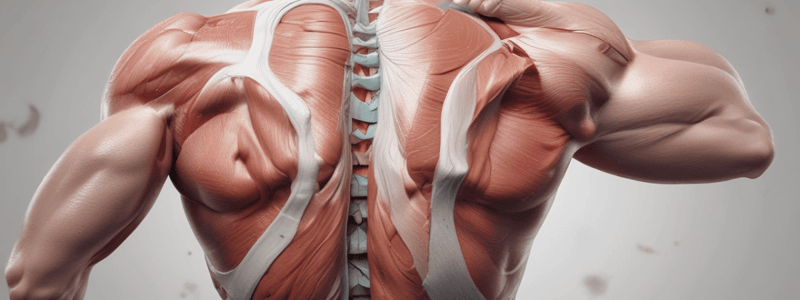Podcast
Questions and Answers
What contributes to increasing the mobility of the shoulder?
What contributes to increasing the mobility of the shoulder?
- Clavicle rotation
- Humerus movement
- Scapula movement (correct)
- Sternum elevation
Without scapula movement, how much shoulder elevation would the glenohumeral joint achieve?
Without scapula movement, how much shoulder elevation would the glenohumeral joint achieve?
- 90°
- 180°
- 60° (correct)
- 30°
What acts like a fulcrum for the clavicle during arm elevation?
What acts like a fulcrum for the clavicle during arm elevation?
- Sternum
- Scapula
- Acromioclavicular joint (correct)
- Humerus
Which joint shifts as the axis of motion above 90° during arm elevation?
Which joint shifts as the axis of motion above 90° during arm elevation?
What is the timing of movement between the GHJt and scapula referred to as?
What is the timing of movement between the GHJt and scapula referred to as?
Which structure allows room in the subacromial space for soft tissue structures?
Which structure allows room in the subacromial space for soft tissue structures?
What is the main role of both upper and lower trapezius in scapula movement?
What is the main role of both upper and lower trapezius in scapula movement?
When does the action of the lower trapezius change from a scapular depressor to upward rotator?
When does the action of the lower trapezius change from a scapular depressor to upward rotator?
Which muscles form a force couple with the upper and lower trapezius to assist upward rotation of the shoulder?
Which muscles form a force couple with the upper and lower trapezius to assist upward rotation of the shoulder?
What is a common observation associated with scapular dyskinesis during shoulder movements?
What is a common observation associated with scapular dyskinesis during shoulder movements?
What is defined as dysrhythmia in the context of scapula movement?
What is defined as dysrhythmia in the context of scapula movement?
What might contribute to scapular dyskinesis, causing the scapula to rest/move in an anteriorly tilted position?
What might contribute to scapular dyskinesis, causing the scapula to rest/move in an anteriorly tilted position?
Flashcards
Shoulder Mobility & Scapula
Shoulder Mobility & Scapula
Scapula movement significantly increases shoulder mobility.
Glenohumeral Joint Elevation
Glenohumeral Joint Elevation
Without scapular movement, the glenohumeral joint can only elevate the arm about 60 degrees.
Acromioclavicular Joint's Role
Acromioclavicular Joint's Role
The acromioclavicular joint acts as a fulcrum for the clavicle during arm elevation.
Changing Axis of Motion
Changing Axis of Motion
Signup and view all the flashcards
Scapulohumeral Rhythm
Scapulohumeral Rhythm
Signup and view all the flashcards
Subacromial Space
Subacromial Space
Signup and view all the flashcards
Trapezius in Upward Rotation
Trapezius in Upward Rotation
Signup and view all the flashcards
Lower Trapezius Transition
Lower Trapezius Transition
Signup and view all the flashcards
Force Couple Muscles
Force Couple Muscles
Signup and view all the flashcards
Scapular Dyskenisis-Winging
Scapular Dyskenisis-Winging
Signup and view all the flashcards
Scapular Dysrhythmia
Scapular Dysrhythmia
Signup and view all the flashcards
Anterior Tilting Scapula
Anterior Tilting Scapula
Signup and view all the flashcards
Study Notes
Shoulder Mobility and Joint Mechanics
- Increased shoulder mobility is influenced by joint capsule flexibility, ligaments, muscles, and neuromuscular control.
- Without scapula movement, the glenohumeral joint can achieve approximately 30 degrees of shoulder elevation.
- The acromioclavicular joint acts as a fulcrum for the clavicle during arm elevation.
Joint Dynamics
- Above 90° of arm elevation, the scapulothoracic joint shifts as the primary axis of motion.
- The timing of movement between the glenohumeral joint (GHJ) and scapula is referred to as scapulohumeral rhythm.
Subacromial Space and Muscle Function
- The subacromial bursa allows for increased space in the subacromial area, accommodating soft tissue structures during shoulder movements.
- Both the upper and lower trapezius muscles play crucial roles in scapula movement, particularly stabilizing and positioning the scapula.
Muscle Action and Force Couples
- The action of the lower trapezius changes from a scapular depressor to an upward rotator when the arm is elevated above 90 degrees.
- The serratus anterior, along with the upper and lower trapezius, forms a force couple to facilitate upward rotation of the shoulder.
Observations and Dyskinesis
- Common observations associated with scapular dyskinesis include abnormal scapular motion, winging, and asymmetry during shoulder movements.
- Dysrhythmia in scapula movement is characterized by the lack of synchronous movement between the scapula and the humerus.
- Factors contributing to scapular dyskinesis may include poor posture, muscular imbalances, and tightness leading to an anteriorly tilted scapula.
Studying That Suits You
Use AI to generate personalized quizzes and flashcards to suit your learning preferences.



